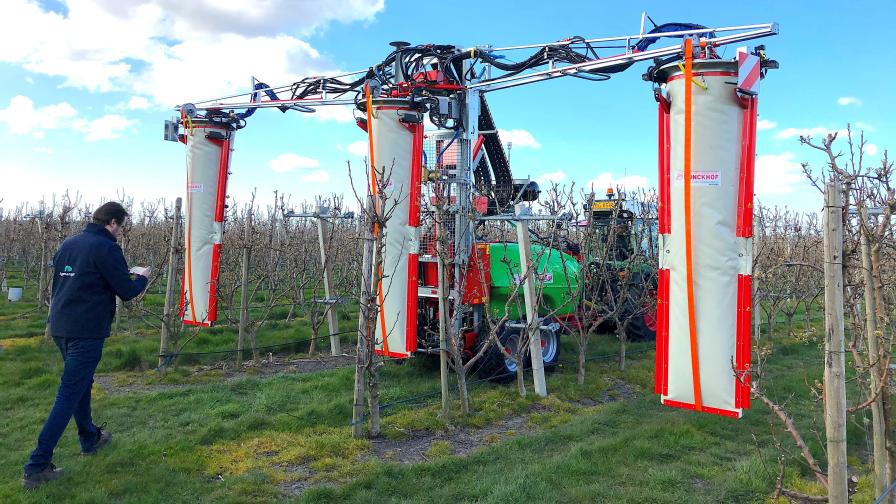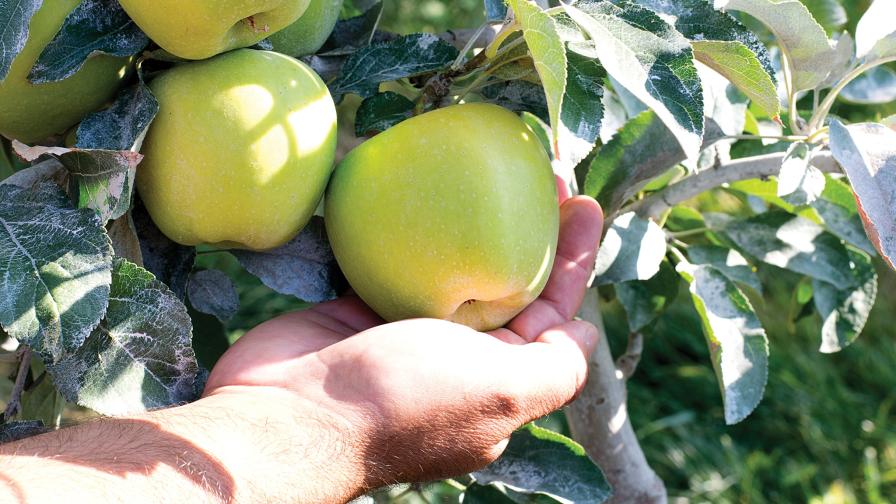Pilot Project Aims To Put Precision Apple Growing on a Higher Plane

In a 10-acre test plot in Michigan, a precision tech pilot project is underway, featuring a demo of fully automated, apple tree-specific blossom thinning and growth regulation.
Photo courtesy of Munckhof Fruit Tech Innovators
Momentum continues to grow behind high-tech tool use in apple orchards. Aurea Imaging, Munckhof Fruit Tech Innovators, and EFC — all Dutch companies — have set up a demonstration project in collaboration with Michigan State University researchers to explore the applications of precision agriculture for cultivating several apple varieties in the U.S., including ‘Kanzi’ apples. The pilot project will include a demonstration of fully automated, tree-specific blossom thinning and growth regulation.
Drone footage, data analysis, and automatic orchard sprayers with GPS technology will be used during the study. The demonstration will take place at the farms of fruit growers Mike Wittenbach and Ronald Rasch in a 10-acre test area.
Drone Footage to Register Blossom Density on Individual Trees
Aurea Imaging will create blossom and vigor maps between late April and early May using drone footage to assess the blossom density and the vigor of each individual tree. The maps will be validated jointly by researchers from the university, Aurea Imaging and the fruit growers. A threshold for minimum blossom density will be determined in consultation with the growers. All trees that are scored below the blossom density threshold will be automatically skipped during blossom thinning, while those above this threshold will receive precision treatment. The trees below this threshold will be treated with a growth regulator to achieve higher and more uniform fruit yields. Treatment with a growth regulator prevents fruit trees from growing too vigorously, and avoids a low rate of fruit growth and maturation and excessively large fruits.
Automatic Conversion of the Blossom Maps to Task Maps for the Automatic Munckhof Sprayer
The blossom maps will automatically be converted to digital task maps for Munckhof’s automatic VariMAS sprayer. This sprayer was chosen for the demo project because of its high drift reduction capability and accuracy, in combination with its low consumption of spraying agents and fuel. The sprayer is equipped with GPS technology that accurately recognizes fruit trees based on digital task maps. The new, fast single-nozzle activation feature, with a response time of 0.2 seconds, allows highly accurate selective activation at individual tree level. The unit executes the spraying strategy fully automatically for each zone. This guarantees that each tree is sprayed based on the correct spraying strategy.
The Maps Lead to Higher and More Uniform Fruit Harvests
The demo’s validation parameters include a number of flower clusters, tree height, shoot length, the number of fruits, and the color and size of the fruits. This application of precision agriculture leads to a higher yield, greater uniformity and better quality, and also reduces the use of spraying agents. Previous demonstrations in the Netherlands resulted in yield increases of 12% to 65%. Tree-specific growth regulation leads to a more uniform and healthier orchard, with proven higher yields.
Publication of the Precision Tech Pilot Project Results and Progress of the Demo
The demonstration project uses existing and proven techniques, however this is the first time that they have been deployed for growth stimulation in the apple cultivation sector in the U.S. The results and status of the demo as it progresses will be published on (social) media and presented at events for fruit growers.
In the Netherlands, trials with the application of precision agriculture have also led to good results in automatic thinning, pear bud weevil treatment, root pruning, and targeted fertilization of individual fruit trees. During these trials, the harvest optimization results were good and growers saved significantly on resources and labor.










